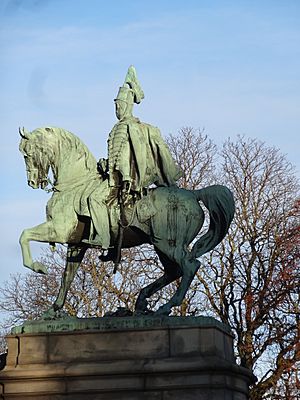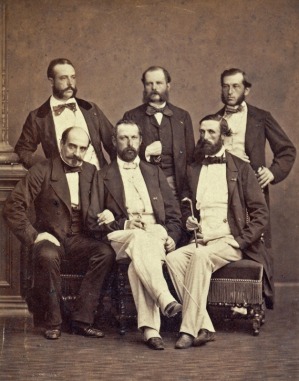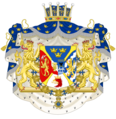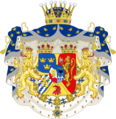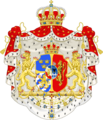Charles XV facts for kids
Quick facts for kids Charles XV & IV |
|||||
|---|---|---|---|---|---|
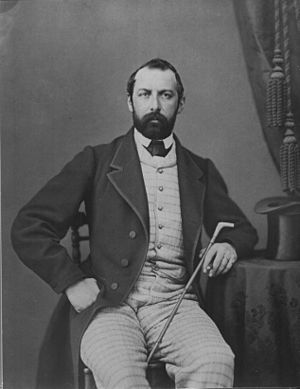
Photograph by Mathias Hansen, c. 1865
|
|||||
| King of Sweden and Norway | |||||
| Reign | 8 July 1859 – 18 September 1872 | ||||
| Coronations | 3 May 1860, Stockholm 5 August 1860, Trondheim |
||||
| Predecessor | Oscar I | ||||
| Successor | Oscar II | ||||
| Born | 3 May 1826 Stockholm, Sweden |
||||
| Died | 18 September 1872 (aged 46) Malmö, Sweden |
||||
| Burial | 9 October 1872 Riddarholmskyrkan |
||||
| Spouse |
Louise of the Netherlands
(m. 1850; died 1871) |
||||
| Issue |
|
||||
|
|||||
| House | Bernadotte | ||||
| Father | Oscar I | ||||
| Mother | Josephine of Leuchtenberg | ||||
| Religion | Church of Sweden | ||||
Charles XV (born Carl Ludvig Eugen) was the King of Sweden and Norway. He ruled from July 8, 1859, until he passed away on September 18, 1872. In Sweden, he was known as Charles XV, but in Norway, he was often called Charles IV. He was the third king from the House of Bernadotte to rule Sweden. Charles was special because he was the first king in his family to be born in Sweden. He was also the first to be raised in the Church of Sweden, which is a Lutheran church.
Contents
About King Charles XV
His Early Life
Charles was born in Stockholm Palace in 1826. When he was born, he was given the title Duke of Scania. He was the oldest son of Crown Prince Oscar and Crown Princess Josephine. This meant he was second in line to the throne after his father. His grandfather, King Charles XIV John of Sweden, was the ruler at the time.
When Charles was 15, his grandfather, the king, made him an officer in the army in 1841.
Becoming Crown Prince
In 1844, Charles's grandfather, King Charles XIV John, became very ill and passed away. Charles's father, Oscar, then became King Oscar I of Sweden. When his father became king, Charles became the Crown Prince. This meant he was next in line to be king.
As Crown Prince, Charles was given important roles. He became a leader for the universities of Uppsala and Lund. In 1853, he also became a leader for the Royal Swedish Academy of Arts. He was even made an honorary member of the Royal Swedish Academy of Sciences in 1846.
Charles was also the Viceroy of Norway for a short time in 1856 and 1857. He became the official Regent (someone who rules for the king when the king cannot) in 1857. When his father died in 1859, Charles became the new king.
On June 19, 1850, Charles married Louise of the Netherlands in Stockholm. Louise was a very educated and refined woman. However, Charles was not always kind to her, which made her very sad. He had a very close and loving relationship with his only daughter, Louise.
His Time as King
When Charles became king, some people were worried because he could be a bit rough around the edges. But he turned out to be one of the most liked kings in Scandinavia. He was a good constitutional ruler, meaning he followed the laws and worked with the government.
His time as king was known for many important changes. New laws were made for towns (1862), churches (1863), and crimes (1864). Charles's motto was: Land skall med lag byggas, which means "With law shall the land be built." He also helped Louis De Geer to change the Parliament of Sweden in 1866, making it more modern.
Charles also helped women gain more rights. In 1858, he passed a law that gave unmarried women the right to be legally independent. His own sister, Princess Eugenie, was the first woman to be declared mature under this new law.
Like his father, Charles believed that the three northern kingdoms (Sweden, Norway, and Denmark) should be united and work together. He was good friends with Frederick VII of Denmark. This friendship led him to promise help to Denmark before the Second Schleswig War in 1864. However, the Swedish army was not ready for war. So, Charles had to keep Sweden and Norway neutral.
Charles passed away in Malmö on September 18, 1872. He was also a talented painter and poet. After his death, his brother, Oscar II, became the new King of both Norway and Sweden.
Charles was very popular with the people. They often called him "Kron-Kalle," which means "Crown-Charlie."
His Children
Charles and his wife, Louise of the Netherlands, had two children. Their son passed away when he was a baby. Their daughter married the King of Denmark. Because Charles's only son died young, his younger brother, Oscar II, became king after him.
- Louise Josephine Eugenie (born October 31, 1851, died March 21, 1926): She married Frederick VIII of Denmark in 1869. They had children, including Christian X of Denmark and Haakon VII of Norway.
- Carl Oscar Vilhelm Frederik (born December 14, 1852, died March 13, 1854): He died as a baby from pneumonia.
No king of Sweden since Charles has been his direct descendant. However, his descendants have become kings or queens in Denmark, Luxembourg, Greece, Belgium, and Norway. A few weeks before Charles died, his daughter Louise had her second son. This young prince was named Charles, after his grandfather. In 1905, this grandson, Prince Carl of Denmark, became the King of Norway and took the name Haakon VII. The current King of Norway, Harald V of Norway, is Charles's great-great-grandson.
Images for kids
See also
 In Spanish: Carlos XV de Suecia para niños
In Spanish: Carlos XV de Suecia para niños



